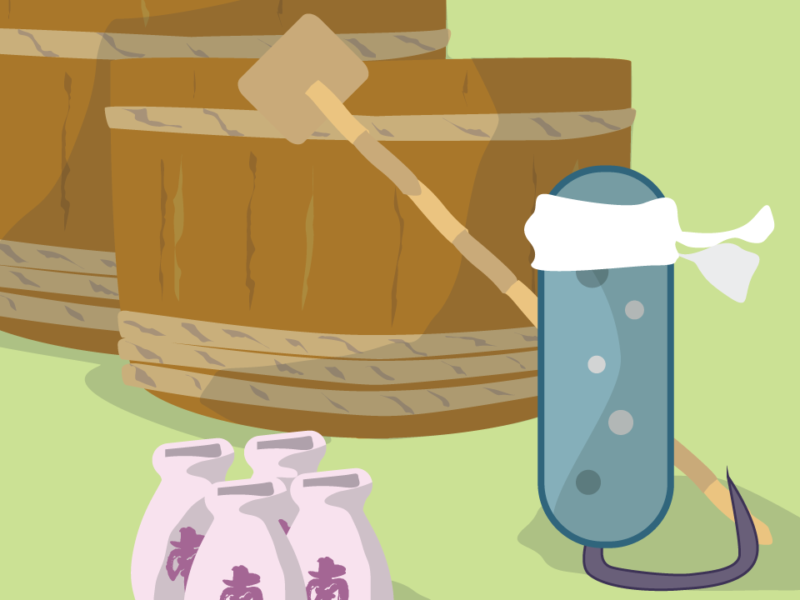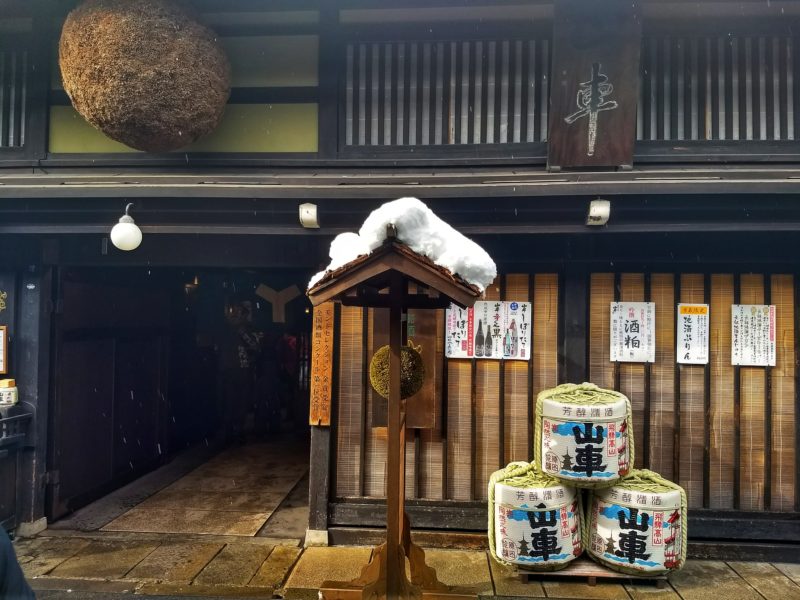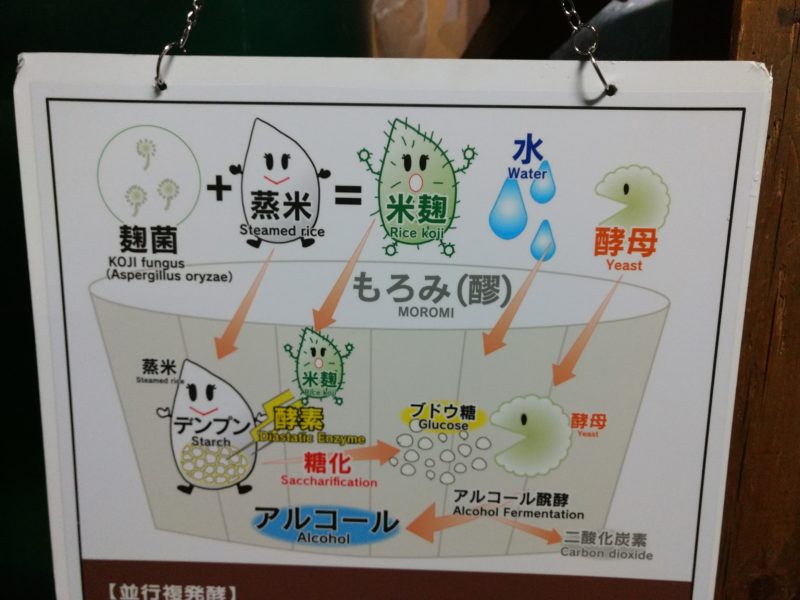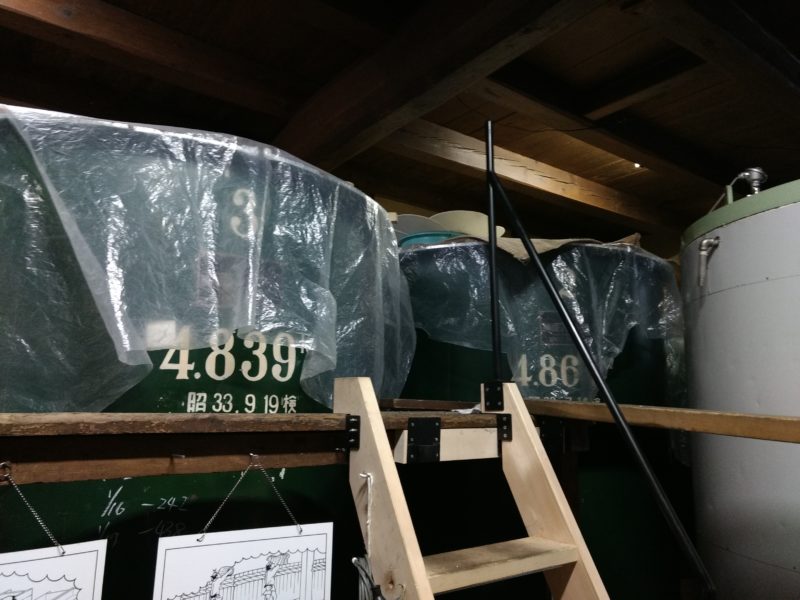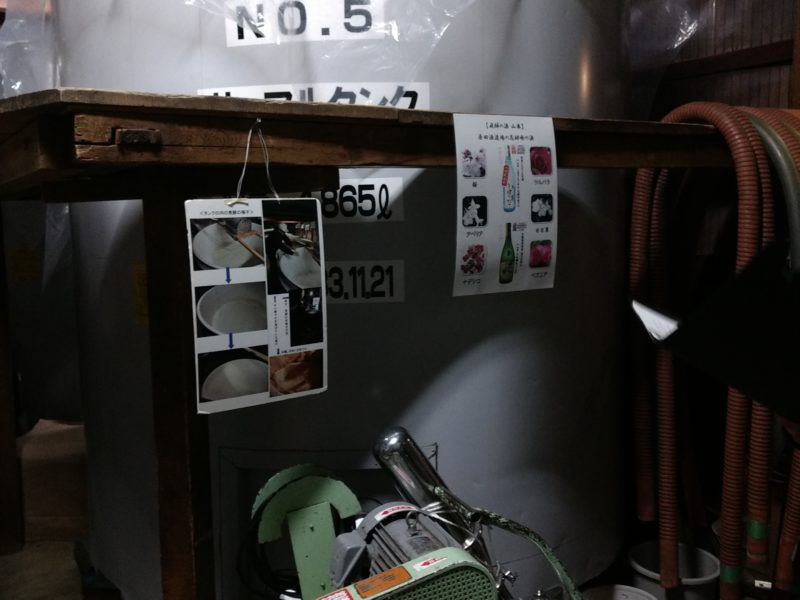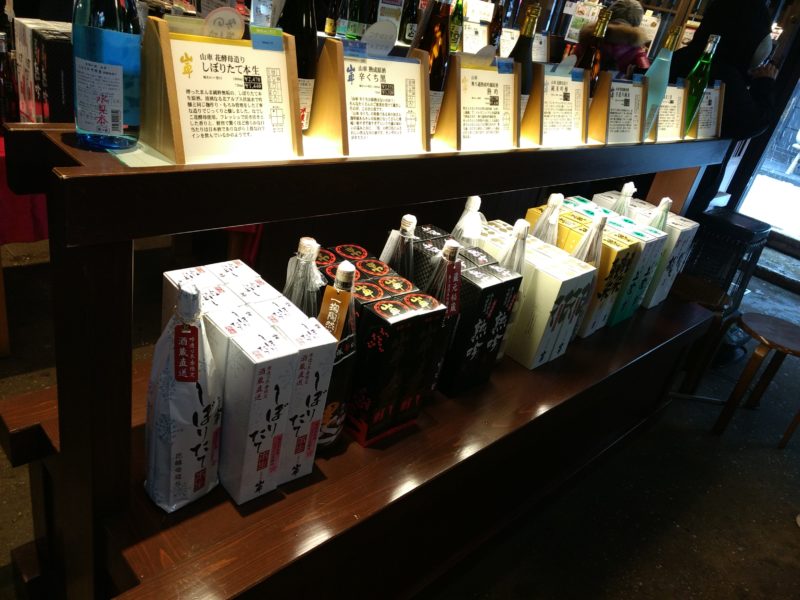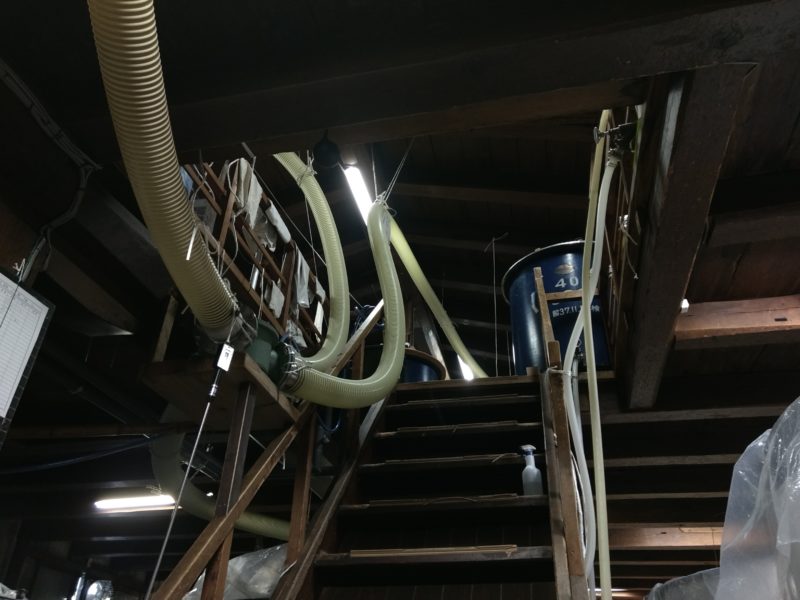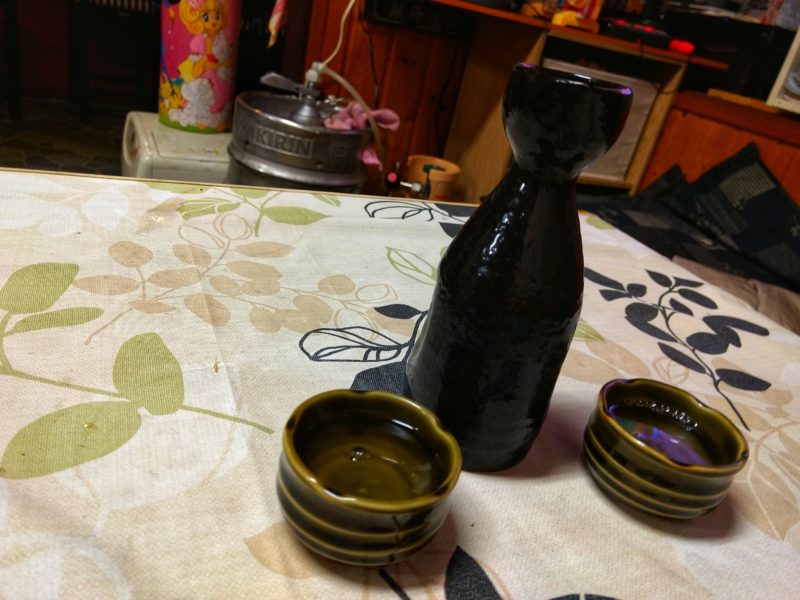Sake is probably one of the most iconic Japanese alcohols. It is referred to as rice wine, but unlike wine where the sugar present in the grapes is fermented into alcohols, sake is produced in a process closer to beer brewing where the starch present in the rice is transformed into alcohol.
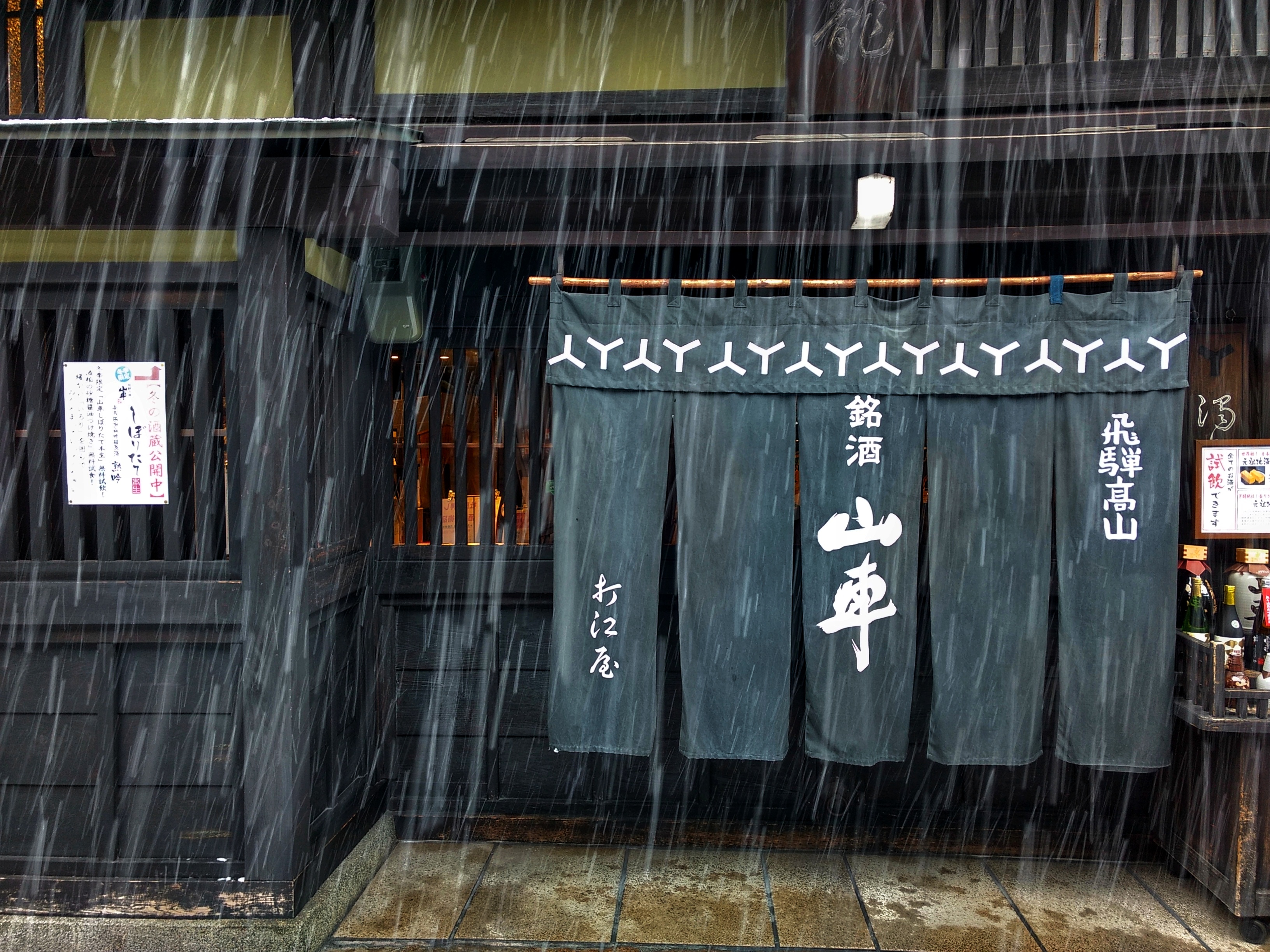
Entrance of the Harada Sake Brewery in Takayama, Japan. We had the chance to visit their production area and taste some of their 15 different Sake products.
History
The origin of sake is unclear, written records such as the “Records of three kingdoms” a Chinese text from the 3rd century and the Kojiki, the oldest extant chronicle in Japan, dating from the early 8th century mention alcohol multiple times, without any of those clearly explicit of these drink being rice wine. Other, difficultly verifiable sources (here and here), believe that rice-based alcohol already existed on the third century when rice was brought from China to Japan, and the first rice wine was brewed for the crowing of an emperor. (Man I need to write history papers you apparently do not need to cite any sources…).
All of these sources appear to agree however that development of the brewing tradition of sake started around the seventh century. Before this period, rice was chewed alongside chestnuts or millet and the wad spit into water in a wooden tub where it was allowed to brew for several days. Lovely. But then around the seventh century when the methods of rice culture became stable, the discovery of brewery using a mould made the sake brewing, reproducible with standard methods. The discovery of using the mould, named Koji, for the fermentation of rice was certainly like for the discovery of beer as rice went mouldy induced the degradation of starch and spontaneous alcoholic fermentation.
From the beginning and up to the Heian Period (794-1195), production of sake was almost entirely controlled by the Imperial Court and was used in religious ceremonies, the Imperial Court, and drinking games. With the rise of Buddhism during the Nara Period (710-794) the Imperial Court allowed Buddhist temples and Shinto shrines to brew sake and became centres of sake production for around 500 years. Brewers were also starting to use massive 1,500-liters vat, allowing for mass production in large facilities outside of shrines and temples. The Muromachi Shogunate (1336-1573) noticed the rise of sake production and recognized the opportunity for an additional source of income and introduced taxes on the production of sake. These taxes would be used by many of the following governments as a sure source of revenue. It culminated during the Meiji Restoration (17th century) where laws were written to allow and promote the creation of small-scale sake breweries. In 1872, there were more than 30 000 sake breweries in Japan, but this number shrunk to about 8,000 over years of increasing taxation.
![]() This piece ended up being much larger than I expected. I initially wanted to point out that, once more, bacteria and other microorganisms play an important role in the preparation of sake, but the main text did not encompass this properly. This box and the next will focus on the Koji, the strange fungus brewer, and the other one the impact of bacteria in traditional sake brewing.
This piece ended up being much larger than I expected. I initially wanted to point out that, once more, bacteria and other microorganisms play an important role in the preparation of sake, but the main text did not encompass this properly. This box and the next will focus on the Koji, the strange fungus brewer, and the other one the impact of bacteria in traditional sake brewing.
The Koji
The Koji (麹), or Aspergillus oryzae, is the key microorganism involved in Sake brewing. Beyond this, it has an important role in Asian culture, particularly in the fermentation industries. It is used for soy sauce, sake, bean curd seasoning, amazake (non-alcoholic rice drink) and miso paste fermenation. Like many other filamentous fungi, A. oryzae produce extracellular enzymes capable of digesting a wide range of compounds. The ability to secrete large amounts of degrading enzymes, which allow it to decompose the proteins of various starches into sugars and amino acids, makes it a candidate of choice for fermenting rice into alcohol. Beyond food fermentation, A. oryzae enzymes were used for biotechnological projects and it was used in the first commercial production of a heterogenous enzyme – a lipase used for laundry detergent in 1988.
The A. oryzae genome was fully sequenced in 2005 and it is composed of 8 chromosomes, a circular mitochondrial genome and has a size of roughly 37,5Mb. In comparison to other members of the Aspergillus genus, A. niger, A. fulgatus, A. nidulans and A. fumigates, this genome is 20 to 30% larger. Accordingly, it possesses 2 to 3000 more genes, all mainly derived from a gene expansion of metabolic genes. These genes include transporter, hydrolases and many secondary metabolite genes. In comparison to the other Aspergillus species, mainly A. niger and A. flavus that have a cluster of 25 genes producing the most potent natural carcinogen, the aflatoxin, A. oryzae has no record of producing aflatoxin or any other carcinogenic metabolites. Phylogenetic comparison of the gene clusters indicates an ancestral acquisition of it in the Aspergillus genome and suggests that A. oryzae somehow lost key genes of either the cluster itself or genes regulating the expression during its industrialization history.
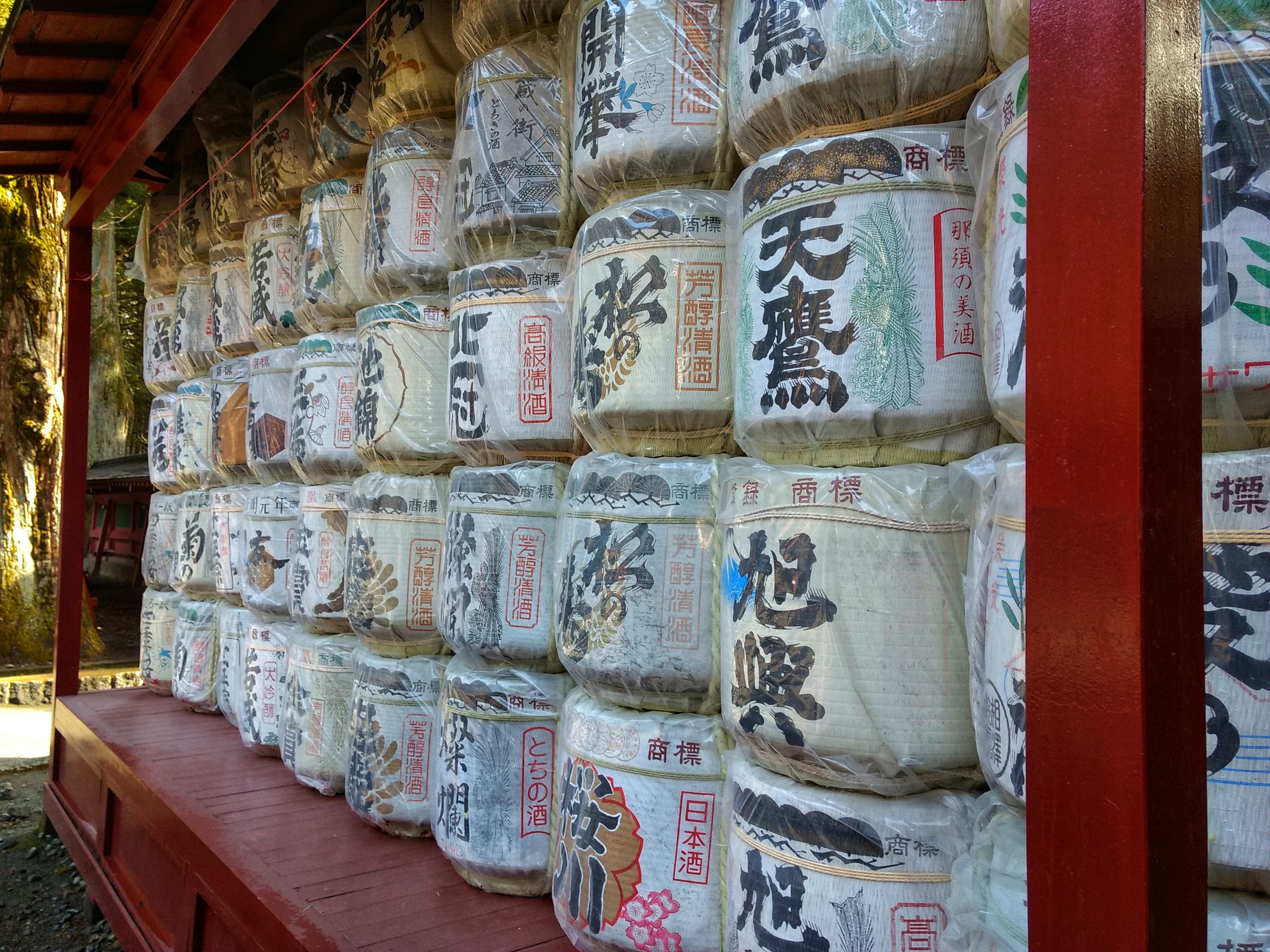
Sake is stored in barrels nicely wrapped in paper. The picture above shows Sake offering to a buddhist temple for a Fountain of Sake ceremony. It is always a good thing to please the local gods with good alcohol to have another prosperous year.
Production
To make a good sake, you need the appropriate rice and a good water. There are apparently more than 80 different rice varieties used only for sake production. These varieties can be summarized in 9 different types, and each type yields specific flavour profiles, just like a chardonnay is not a merlot (More detail here ). For the water, the perfect characteristics are low iron content, since it is said to ruin the colour, scent, and taste and adequate levels of potassium, magnesium, and phosphoric acid to help the yeast and koji develop. Although rice and water are important, many say that the further steps of the brewing process will also have a great impact on the final taste.
The first step of the brewing process is to make the starch inside the rice as available as possible to the yeast and koji to ferment into alcohol. The process begins by reaching the starch centre of the rice, called the shinpaku (心白), by “polishing” the harvested rice. This is considered the relatively desirable part of the grain, and so the rice is polished to remove the bran, a little fibrous brown shell enveloping the white rice. Here the type of rice is important, stronger and larger types of rice prevent grains from breaking during the polishing. As little as 30% and as much as 65% of the kernels can be removed during polishing, and removing different amounts results in different tastes. After polishing, the rice needs to be left alone for about 10-20 days before washing/soaking.
The washing and steaming step are also prepared to make the rice soft and accessible to the yeasts. Sake is typically prepared in winter, during the cold months, to minimize unwanted microbial growth, using cold water to moist the rice first and let it soak for a night. Then it’s steamed to soften the grain. Unlike table rice, which is cooked in water, steamed rice is still quite firm. The most important factor for the fermentation mash is to ensure that the steamed rice grains are separated from each other and not stuck together. Some sake brewery might even do a quick pasteurization step at this point to remove potential contamination and ensure a controlled fermentation.
The fermentation step can now start. First, koji is sprinkled on a small batch of the steamed rice with water. This mixture, called moto, is placed in a cellar called the Koji room where a high temperature and humidity level are maintained for 36-45 hours, during which the brewers will monitor and frequently mix or rearrange the batch. Only about 100 grams of the koji powder is enough for 1 ton of sake! Once the smaller batch is prepared, more of the basic ingredients are progressively added in the second step. Modern production of sake will add a yeast, such as Saccharomyces cerevisiae, and let it develop for several days at a lower temperature.
Once the two previous fermentation steps are done, the fermentation starter is moved to a larger vat and mixed with additional rice and water. The brewers will monitor the batch over the next 20 to 40 days, making sure the temperature, humidity, and other factors are controlled to ensure the quality of the final product. Unlike malt for beer, rice for sake does not contain the amylase necessary for converting starch to sugar; it must undergo a process of multiple fermentations. Koji provides the necessary proteins to hydrolyze the rice nutrients that support the yeast growth. As mentioned before, this is the step where these two processes take place at the same time so sake is said to be made by multiple parallel fermentation.
 Kimoto, the traditional Sake
Kimoto, the traditional Sake
With the industrialization of Japan, the production of Sake was improved from traditional methods to faster, more effective and efficient modern methods. Until about 1920, all sake was made by mixing rice, koji, and water to a puree in order to help the yeast cells reproduce faster. This yeast starter needed to be properly tended; kurabito (brewery workers) would ram oar-like poles into the small vat for hours on end to make a smooth paste of the contents. However, in 1909, a researcher showed that the mixing wasn’t really needed if the vat temperature was increased a bit and more water added. Even more, in 1911 it was discovered that by adding a bit of lactic acid to the moto at the beginning, the whole thing could be accomplished in about half the time and would prevent wild yeast and unwanted bacteria from proliferating and adversely affecting the flavour.
Now back to the Kimoto preparation, a study looking at this traditional preparation method showed a dynamic microbial succession, with koji and early moto fermentations dominated by Bacillus, Staphylococcus, and Aspergillus flavus var. oryzae, succeeded by Lactobacillus spp. and Saccharomyces cerevisiae later in the fermentation. The study also investigated the equipment and direct surroundings of the Kimoto preparation area and found that the microbial reservoir is likely to be the brewery itself. Kimoto brewing takes longer than modern Sake preparation but sake brewed with a Kimoto moto has a higher sweetness and acidity, with richer, deeper, significantly more pronounced flavours. Probably influenced by the richer microbial diversity of traditional brewing.
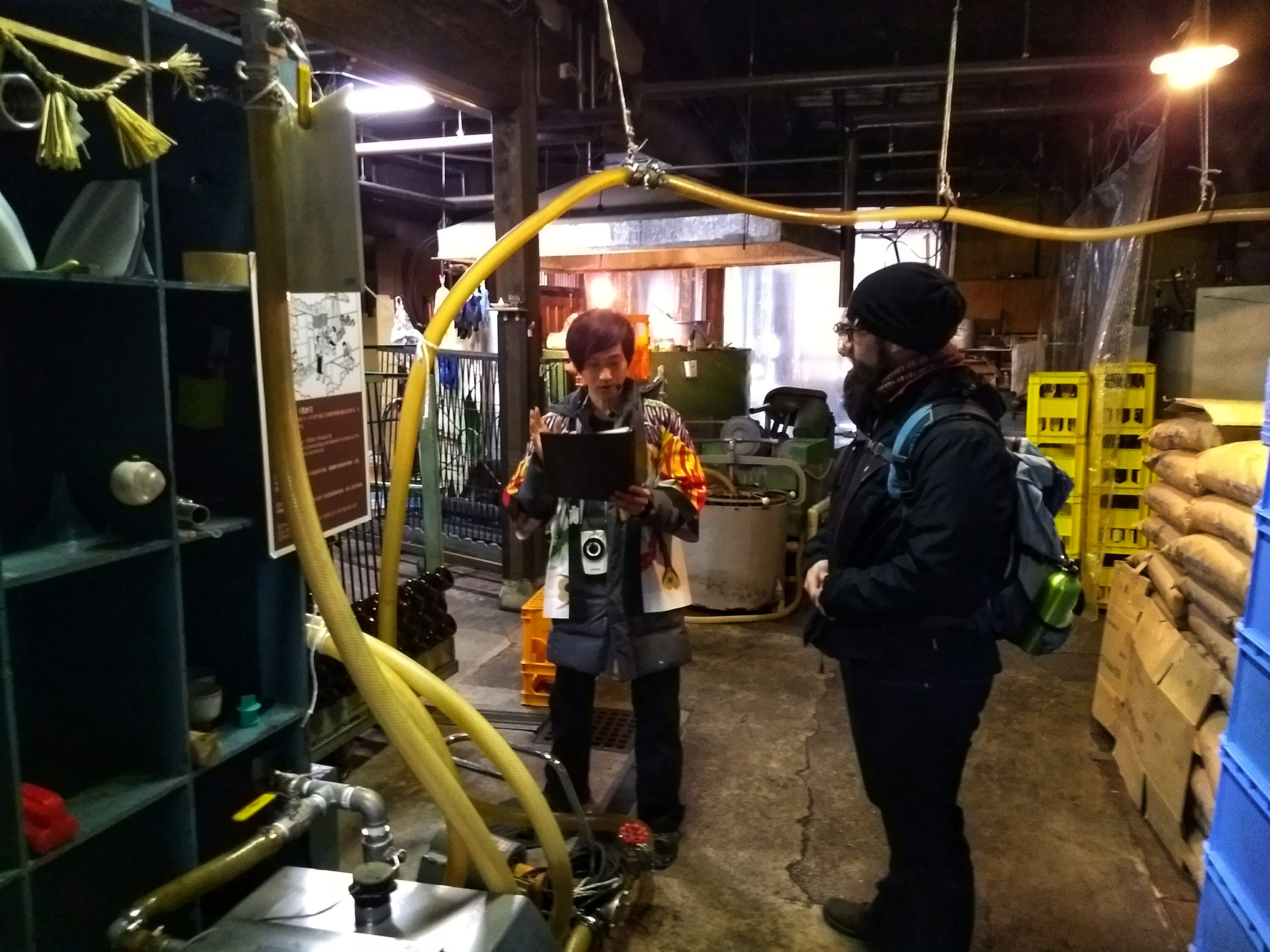
Picture of me trying to have more information about Koji from our guide who barely spoke English.
After a couple of fermentation weeks, the final product is ready for the final stages. The fermentation mixture is diluted with water, to reduce the alcohol percentage and adjust the final flavours. Then the sake is “pressed”, or more precisely filtered. There are different techniques to extract the alcohol from the fermented mash. Sake is said to be “pressed”, because the liquid and mixture are mechanically pressed through a filter mesh. Then the liquid is filtered once more through a charcoal filter to remove the last solid fragments. Without the filtration, the sake might have a yellowish-green tint to it.
Filtered sake is pasteurized, which improves the storage process and removes any bacteria that might grow on the lactic acid generated during the fermentation and spoil the taste. Interestingly diaries of Buddhist priests in the Muromachi Period (1336-1573) prove that sake brewers were already using a pasteurization technique called hiire (火入れ), where heat applied to the sake would kill bacteria.
Sake, like many other good spirits, is then matured for 4 months to a year. The sake is transferred to sealed vats, traditionally fabricated from Japanese cedar, where the sake will acquire extra flavour from the wood.
Now the sake is ready to be pasteurized one last time then bottled, shipped and savoured.
